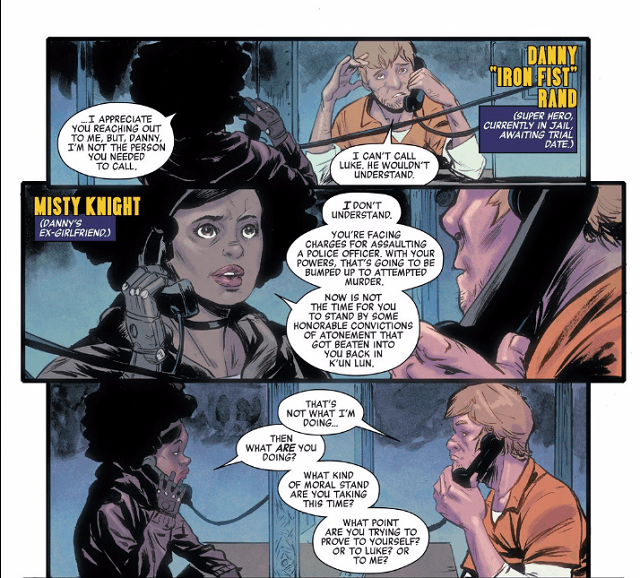At their very best, comic books and graphic novels use fictional characters to speak on society at large. With the last three issues of Marvel’s revamped Power Man and Iron Fist series, we find our heroes tackling the dark side of the prison industrial complex and police profiling.
Written by David Walker and illustrated by artists Sanford Greene and Flaviano, this particular story arc takes place in the shadows and on the streets of the Civil War II story line while the rest of the world’s major superheroes are battling it out over the predictions of a young Inhuman named Ulysses, who possesses the power to see and feel the future.
He also has the ability to superimpose that experience onto those in his immediate vicinity as well. The two factions are divided between those who follow Captain Marvel, who believes the visions are an accurate predictor of the future, and Iron Man, who believes the future is not set, thus individuals should not be arrested (or worse) for things that they haven’t even done yet.
In Iron Man #7, Power Man and Iron Fist are approached by a young woman named Marta Cabrera to help find her missing father – ’70s Captain America/Nomad minor villain Gamecock (Yeah, I chuckled too) aka Carlos Cabrera, as well as another ’70s character, Cockroach Hamilton and other family members of the wrongly accused for protection.

Turns out, Cabrera, along with the Mangler, another Captain America punching bag from back in the day who also tussled with Power Man, as well as other former villains, are being kidnapped by a group of bounty hunters that utilize a nefarious piece of software that has the ability to reactivate the files on expunged and dropped criminal charges as if the victims are currently wanted.
They then deliver them to the police, who ask no questions. That’s likely because many of the people they’re locking up used to raise all kinds of heck back in the day. So, law enforcement figures they’re guilty without second guessing their own files. The reasons for bounty hunters doing this are a bit vague, other than for profit, through issue #8.
Being incarcerated on trumped up charges is part of Luke Cage’s origin story and he is all in to help solve this mystery.

After attempting to visit Jennifer Walters aka She-Hulk, who was in a coma due to the disastrous mission to preempt Thanos, which also resulted in the death of War Machine, the duo agrees not to venture into another conflict that would have them fighting other heroes ever again.
As the former criminals and their proxies gather at Heroes for Hire headquarters, the mysterious bounty hunters attack in what looks like high tech police riot gear. As the fighting begins, real police show up and are getting their hats handed to them in the fog of combat because they look similar to the bad guys. Everyone but Luke Cage, Cockroach Hamilton and Marta Cabrera escape while everyone else is carted off to the slammer.
While incarcerated, Iron Fist finds that not only are retired and reformed villains being locked up, but innocent kids are as well. Though he has the ability to bail himself out or fight his way out, Danny Rand decides to stay, as he and Cage try to come up with a plan to get all of the innocents who have been accosted by this group of bounty hunters set free as well.

At the end of #8, Luke Cage has gathered a few friends and is still contemplating whether or not he’s going to break his partner out of Rikers. The immensely powerful Captain Marvel, accompanied by Storm, Deathlok, Puck, Spectrum, Mockingbird and a squad of Shield agents, arrives after Ulysses has a vision that predicts he will go through with it. As the issue ends the fight begins, but it’s looking like a loss for ol’ boy.
This book is so relevant to today’s environment in so many ways. One kid told Fist that he had been locked up for three months with no trial in site and shed tears proclaiming his innocence, which is exactly the sort of thing that’s been happening on Riker’s Island for decades. Also, the idea of preemptively locking people up because you “believe” they might do something in the future is in the same philosophical family as stop-and-frisk and racial profiling.
The story is written by David Walker, someone who knows the language to use and the significance of the plot to contemporary issues.
I also liked the way they brought back some old school, long forgotten villains from damn-near 40 years ago, all of whom were black or Hispanic. That hammered home the racial dynamic without having to announce it with a billboard ad.
The artwork is very good but I kind of felt like it was too “cartoony” and seemed out of place with the seriousness of the issues being tackled, although there are plenty of comical moments. But it works very well for the cover.

